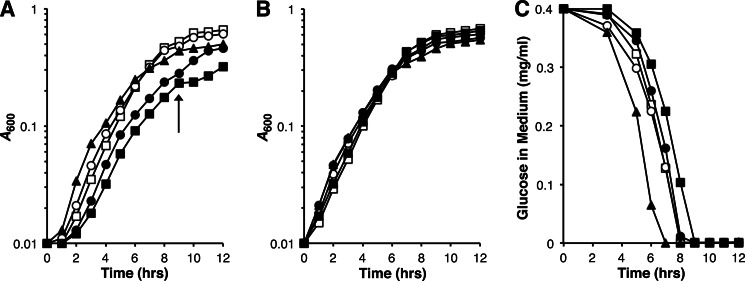FIGURE 2.
Effect of K+ on AmtB twin-histidine variant strain growth. A and B, strains were cultivated in either K+-based N−C− minimal medium (contains 200 mm K+) (A) or Na+-based N−C− minimal medium supplemented with 1 mm KCl (B). All media contained 0.04% glucose and 3 mm glutamine. AmtB is expressed under these growth conditions (see “Experimental Procedures” for details). Strain genotypes were wild-type (○), amtB-null (□), H168D (▴), H318D (●), and H168D,H318E (■). The arrow in A denotes the point at which the glucose supply is exhausted by cells expressing AmtBH168D,H318E (see C), and the tricarboxylic acid cycle intermediates derived from glutamine begin to be used as the source of carbon. The data, from a single experiment, are representative of findings made in three independent trials. C, glucose consumption by strains illustrated in A. Culture medium glucose concentrations were determined at various times during growth. The times at which strains exhaust their glucose supply are closely approximated by their diauxic shift points in A: 7 h for H168D, 8 h for amtB-null, 8 h for wild type, 8 h for H318D, 9 h for H168D,H318E. Cell yield per glucose consumed values (shown below in units of A600/mg of glucose per ml) at the diauxic shift point for each strain were 1.2 ± 0.12 for amtB-null, 1.1 ± 0.063 for wild-type, 0.73 ± 0.052 for H168D, 0.62 ± 0.029 for H318D, and 0.55 ± 0.025 for H168D,H318E. Cell yield per glucose consumed values are reported as means ± S.D. for three independent experiments. Symbols used for strain genotypes in C are identical to those in A and B.

